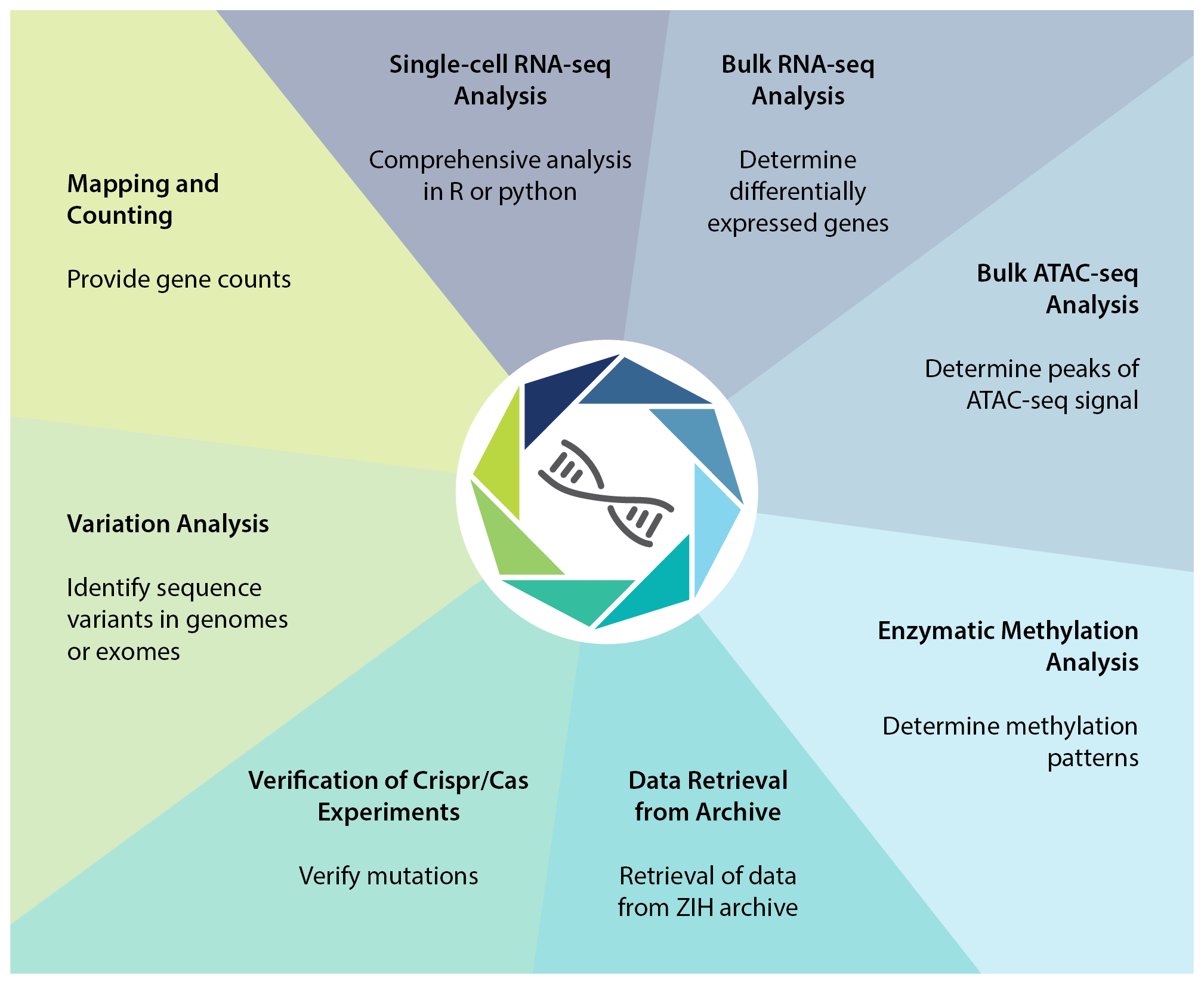DcGC Bioinformatics Portfolio
The bioinformatics team of the DRESDEN-concept Genome Center engages in
- Data Analysis
- Teaching
- Troubleshooting of experiments
- IT Infrastructure
- Development
- and SARS-CoV-2 Mutation Analysis.
Data Analysis
Our analysis workflows include QC, analysis, summary of the results to HTML reports, and export of the data so you can further explore your processed data. We meet our collaborators to discuss the analysis, the results and open questions.

Bulk ATAC-seq Analysis
We are using and are actively contributing to the nfcore/atacseq pipeline. This pipeline maps raw ATAC-seq reads against the reference genome, filters the alignments, calls peaks, and performs differential accessibility analysis. Results can be viewed in a Genome Browser. The analysis output and potential next steps are further described here.
Bulk RNA-seq Analysis
Our in-house pipeline maps raw RNA-seq reads against the reference genome, counts mapped reads per gene, corrects for batch effects, correlates samples based on different measures, visualizes variable and highly expressed genes, and compares gene expression between different conditions of interest to identify differentially expressed genes. The analysis output and potential next steps are further described here.
We organized a license for the software Ingenuity Pathway Analysis (IPA), and once you have gone through an initial registration process, you can book the software to further analyze your data.
Single-cell RNA-seq Analysis
For 10x Genomics data, we run Cellranger for initial QC. The analysis output and potential next steps are further described here.
We also analyse data generated with 10x Genomics and SmartSeq-2 technologies in depth. We either use a workflow based on Seurat, or based on scanpy. Both workflows implement current best practices in single cell analysis. The workflows include QC, normalization, cell cycle scoring, dimension reduction PCA, clustering, 2D visualization UMAP, visualization of known marker genes, identification of cluster marker genes, identification of differentially expressed genes between conditions of interest, functional enrichment analysis, and export of files to several cell browsers.
CMCB collaborators can further explore their data online in our cellxgene viewer.
Mapping and Counting
This basic workflow maps raw RNA-seq reads against the reference genome, and counts mapped reads per gene.
Variation Analysis
Our in-house pipeline maps raw reads against the reference genome, and identifies germline and somatic small nucleotide variants (SNVs), and copy-number variants (CNV). Functional annotation is done to predict the effect of the variants on genes, transcripts, and proteins, as well as regulatory regions.
Verification of Crispr/Cas Experiments
Rapid and intuitive interpretation of Crispr/Cas editing experiments is done with CRISPResso2. The tool maps reads to the target region of the editing event and quantifies substitutions, insertions and deletions (indels). For coding regions, insertions and deletions are further categorized into frameshift and in-frame events. The resulting tables and plots are summarized as HTML file.
Enzymatic Methylation Analysis
To be written (Mathias)
Data Retrieval from the Archive
Uploaded sequencing data and analyses will be available for 60 days so that they can be downloaded and stored safely in a reasonable amount of time. Afterwards, they will be archived at the TU Dresden center for information service and high performance computing (ZIH). This service includes retrieval of data from the ZIH archive and re-upload to our file server.
Teaching
- Monthly Data Analysis Cafe
- Regular R course for Master students
- Regular single-cell RNA-seq analysis lecture
- Consultation Experimental Design
Troubleshooting of experiments
- Custom QC for sequencing data generated at the DcGC
IT Infrastructure
- Primary processing of raw data
- Sharing data with clients
- Archiving data
Development
- Staying up to date with literature
- Development of new workflows
- Development of new ways to share results
SARS-CoV-2 Mutation Analysis
- Biweekly SARS-CoV mutation analysis to support surveillance studies of the RKI